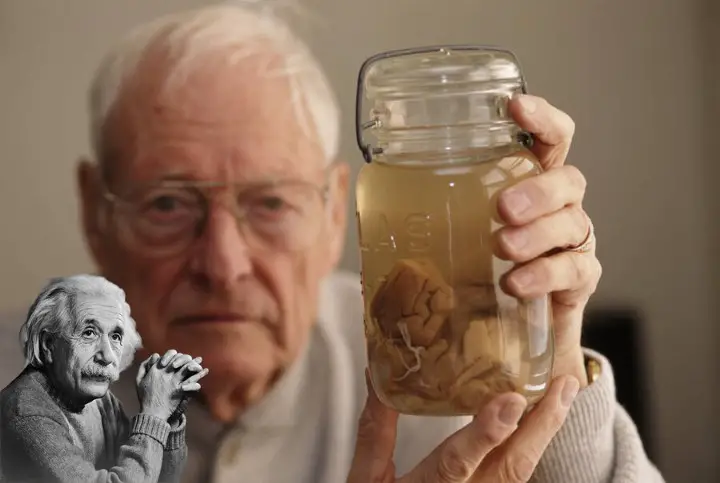 lbert Einstein is considered to be the brightest mind this world has ever seen and for good reasons. His achievements within the scientific field had changed the world as well as the way we see life. Throughout his career, many biologists tried to understand what exactly was different at an anatomical level that made him so intelligent. As sad as it may sound, many of those who had an interest to discover what was the secret awaited his death so they could dissect him. Einstein already knew that his brain was of great interest and he told his family that he does not want his brain studied. His last wishes were for his body to be cremated and his ashes scattered secretly so that no fanatic would take them.
lbert Einstein is considered to be the brightest mind this world has ever seen and for good reasons. His achievements within the scientific field had changed the world as well as the way we see life. Throughout his career, many biologists tried to understand what exactly was different at an anatomical level that made him so intelligent. As sad as it may sound, many of those who had an interest to discover what was the secret awaited his death so they could dissect him. Einstein already knew that his brain was of great interest and he told his family that he does not want his brain studied. His last wishes were for his body to be cremated and his ashes scattered secretly so that no fanatic would take them.
Around April 1955, Einstein started to fall ill. Brian Burrel published a book in 2005 entitled, “Postcards from the Brain Museum” in which he described that Einstein knew that his time was coming. On April 18th, 1955 Einstein was rushed to Princeton Hospital where he passed a couple of hours later, at the age of 76.
Stealing the Greatest Mind in the World
The medics weren’t sure what was the exact cause of death, so they followed to perform an autopsy which was led by pathologist Thomas Harvey. Harvey was well aware of the wishes made by Einstein, but his fanatic mind didn’t stop him from stealing Einstein’s brain. Days later Harvey was questioned about the brain. That is when he went to Hans Albert (Einstein’s son) to ask for his blessing to study the brain, all in the interest of science.
Despite Hans Albert giving his blessing to Harvey, he was fired from his role as a pathologist from Princeton Hospital. Harvey took the brain to Philadelphia, where he started to analyze it in order to find the secret to Einstein’s vast intelligence. The brain was carved into 240 pieces which were all preserved in a liquid called celloidin. The pieces were placed in two separate jars and left in the basement just like pickles.

The reason he cut the brain into so many pieces was to share Einstein’s brain with other researchers around the world that were as interested as him. As weird as it sounds, a part of Einstein’s brain was sent around the world in a package as if it was a coveted object. Harvey’s wife threatened him that she will personally dispose of the brain as it just freaked her out. Author Burrell gives examples of accounts that show the strange places the brain had been taken or kept.
“For a time he worked as a medical supervisor in a biological testing lab in Wichita, Kansas, keeping the brain in a cider box stashed under a beer cooler. He moved again, to Weston, Missouri, and practiced medicine while trying to study the brain in his spare time, only to lose his medical license in 1988 after failing a three-day competency exam. He then relocated to Lawrence, Kansas, took an assembly-line job in a plastic-extrusion factory, moved into a second-floor apartment next to a gas station, and befriended a neighbor, the beat poet William Burroughs. The two men routinely met for drinks on Burroughs’s front porch. Harvey would tell stories about the brain, about cutting off chunks to send to researchers around the world. Burroughs, in turn, would boast to visitors that he could have a piece of Einstein any time he wanted.” (Quote by Brian Burrell taken from the book Postcards from the Brain Museum)
There is no record to show how many pieces of Einstein’s brain have been shipped away. Some pieces have been left as big chunks as presented in the first image, whilst other pieces had been thinly cut out (as presented in the second image) in order to be closely analyzed under the microscope.
Was Einstein’s Brain Special?
At the end of the day, the only reason why Harvey stole the brain and shared it with other fanatics like himself was to see if there was a secret behind Einstein’s intelligence. In 1985 Harvey and other collaborators of his in the analyses of the brain published the first study which concluded that “Einstein’s brain did not differ significantly from the average brain. Other studies followed that showed small differences as Einstein’s brain had additional cells.
However, these studies have been highly criticized by scholars within the field, stating that intelligence has nothing to do with the anatomy of the brain. Also, Einstein’s brain wasn’t the freshest to analyze as it had been pickled for over 30 years at that time. Other scholars say that Einstein’s brain pieces could help scientists discover what part of the brain developed intelligence.

In 1996 Harvey partnered with scientist from Alabama named Britt Anderson to do another study. In this study, the two counted the neurons present in the pre-frontal cortex of the brain. It turned out that Einstein’s brain once again didn’t differ from the control group, therefore not making it special. Another journal was written in 1999 where Harvey shared a rare photo (the one above) of Einstein’s intact brain before being cut up. He explained that Einstein had an abnormal folding pattern in part of his parietal lobe, a region that has been linked to mathematical ability. They also reported that his parietal lobes were 15 percent wider and more symmetrical, than those of control brains.
Once again, these studies received a lot more criticism than positive comments, not necessarily because it was stolen, but because from an anatomical point of view Einstein’s brain was far from special. Another study had been carried out by a handful of experts in neurology in 2014. Once again the study received its fair share of criticism as it replicated the conclusion of previous studies, only using more advanced equipment and a new theory. Maybe intelligence has a link with the consciousness of our minds rather than our brains.
Thomas Harvey had passed away in 2007, but before his death, he donated the remainder of Einstein’s brain to the National Museum of Health and Medicine. Some of the samples are on display today at Philadelphia’s Mütter Museum. What is interesting to note is that some of Einstein’s brain pieces are still lost and scattered around the world.
Avid Writer with invaluable knowledge of Humanity!
Upcoming historian with over 30 million views online.
“You make your own life.”





